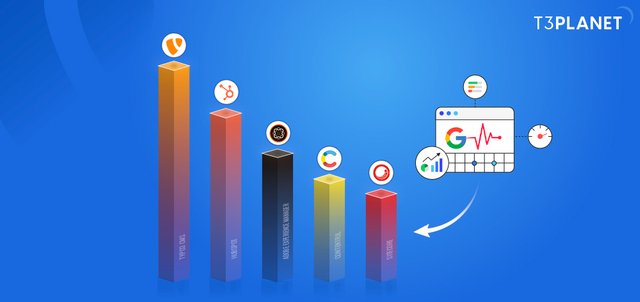Explore why TYPO3’s performance on Core Web Vitals is being considered the new standard for CMS platforms. We’ll delve into how TYPO3 has evolved to set the stage for faster, more efficient web experiences in 2025 and beyond.

Core Web Vitals: Key to Website Performance and User Experience
Core Web Vitals are a set of performance metrics introduced by Google to measure the real-world user experience on websites. These metrics focus on three crucial aspects:
Largest Contentful Paint (LCP): LCP tracks how quickly the largest visible content element (like an image or block of text) appears on the screen. A score under 2.5 seconds is ideal for a smooth and fast loading experience.
First Input Delay (FID): FID measures the time it takes for a website to respond after a user interacts with it, such as clicking a button or link. A score under 100 milliseconds ensures a quick response to user actions.
Cumulative Layout Shift (CLS): CLS measures the visual stability of the page during loading. A score below 0.1 ensures that elements on the page don't unexpectedly shift, improving the overall stability and usability of the site.
Why Core Web Vitals Matter for TYPO3 Websites
Optimizing Core Web Vitals is essential for TYPO3 websites for the following reasons:
SEO Impact: Google has integrated Core Web Vitals into its ranking algorithm. Websites with better performance on these metrics are more likely to rank higher in search results, helping improve visibility and traffic.
Enhanced User Engagement: A fast-loading website with responsive interactions and stable content encourages visitors to stay longer, engage more, and return in the future, improving user retention.
Tools to Measure Core Web Vitals
To measure and monitor Core Web Vitals on TYPO3 websites, the following tools can be used:
PageSpeed Insights: A tool that provides a detailed analysis of your website’s Core Web Vitals performance, offering suggestions for improvements in load speed, responsiveness, and stability.
Google Search Console: Offers a Core Web Vitals report that helps identify issues affecting your website’s performance and tracks progress over time.
Web Vitals Extension: This browser extension offers real-time feedback on the performance of your site’s Core Web Vitals, helping you identify and address issues as they arise.
Improving Core Web Vitals on TYPO3 Websites
Here are some strategies for improving Core Web Vitals on TYPO3 websites:
Optimize Images: Compress and serve images in formats like WebP to reduce their file sizes, which helps to improve page load times.
Minimize JavaScript and CSS: Remove unused JavaScript and CSS, and defer non-essential scripts to ensure that critical content loads quickly and the page responds promptly to user interactions.
Implement Caching: Use browser and server-side caching to store static content and resources, speeding up the load time for returning users.
Leverage Content Delivery Networks (CDNs): CDNs distribute content from multiple locations worldwide, reducing latency and improving the loading speed for global users.
Optimize Server Performance: Ensure that your web server is optimized to handle requests efficiently, reducing server response times and improving overall performance.
Conclusion
Optimizing Core Web Vitals is an important step for TYPO3 website owners who want to improve user experience and SEO performance. By focusing on fast loading times, interactivity, and visual stability, websites can provide a better browsing experience, increase user engagement, and improve search rankings. Regular monitoring and improvements to these metrics are essential for maintaining a competitive edge in search results while offering a seamless user experience.
